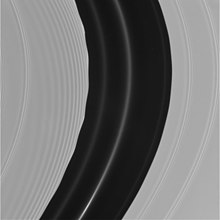Enckeho dělení
Enckeho dělení či Enckeho mezera je mezera v prstencích Saturnu, konkrétně mezera v prstenci A. Dělení je přibližně 300 km široké a vytváří rozhraní mezi strukturami v prstencích.[1] Oproti Cassiniho mezeře není tak výrazné.
Enckeho dělení nejspíše vzniklo jako výsledek opakovaného průchodu malého měsíce Pan skrz prstenec A, což nakonec vedlo k vyčištění části prstence o většinu materiálu.[1] Dělení bylo pojmenováno po německém astronomovi Johannu Franzi Enckem.

Reference
- ↑ a b Astronomický snímek dne - Enckeho dělení [online]. [cit. 2008-12-03]. Dostupné online.
Média použitá na této stránce
Panoramatický pohled na Saturnovy prstence s popisky v češtině
This is a narrow-angle camera image of Saturn's rings taken after the successful completion of the orbit insertion burn when the spacecraft had crossed the ring plane and was looking upwards at the lit face of the rings. The image shows details in the Encke gap (325 kilometers, 202 miles wide) in Saturn's A ring. The center of the gap lies at a distance of 133,600 kilometers (83,000 miles) from Saturn. The image shows a ring in the center of the gap. The wavy inner edge of the gap and the wake-like structures emanating from its inner edge are caused by the tiny moon Pan that orbits in the middle of the gap. Two fainter ring features are also visible in the gap region.
Cassini was approximately 195,000 kilometers (121,000 miles) above the ringplane when the image was obtained. Image scale is approximately 1 kilometer per pixel.
The Cassini-Huygens mission is a cooperative project of NASA, the European Space Agency and the Italian Space Agency. The Jet Propulsion Laboratory, a division of the California Institute of Technology in Pasadena, manages the Cassini-Huygens mission for NASA's Office of Space Science, Washington, D.C. The imaging team consists of scientists from the US, England, France, and Germany. The imaging operations center and team lead (Dr. C. Porco) are based at the Space Science Institute in Boulder, Colo.
The original NASA image has been edited slightly to remove artifacts.

